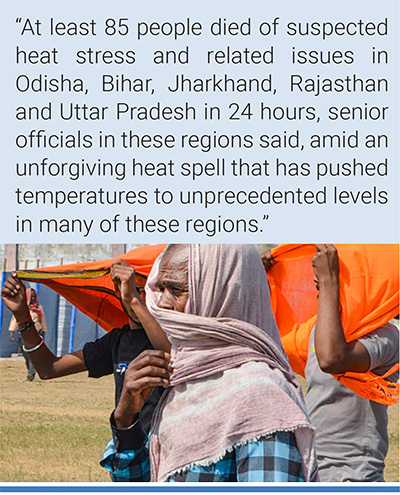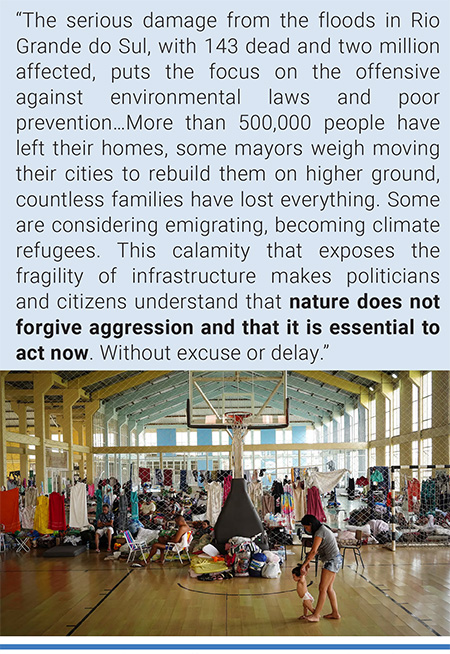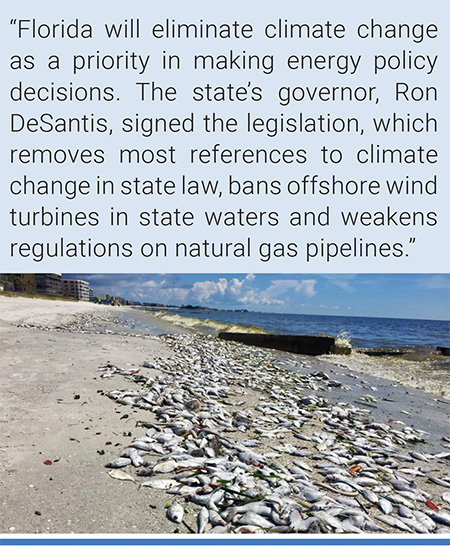Monthly Summaries
Issue 89, May 2024 | "If it hasn't pushed you over the edge yet, just wait"
[DOI]

Kristin Peterson tries to cool off with a cold bandana at Sonrise Homeless Navigation Center in Austin, Texas. Photo: Jay Janner/Austin American-Statesman via AP.
May media coverage of climate change or global warming in newspapers around the globe crept up nearly 1% from April 2024. Meanwhile, coverage in May 2024 was down 13% from May 2023 levels. In May, international wire services increased 16% from the previous month, as radio coverage also went up 46% from the previous month. Figure 1 shows trends in newspaper media coverage at the global scale – organized into seven geographical regions around the world – from January 2004 through May 2024.

Figure 1. Newspaper media coverage of climate change or global warming in print sources in seven different regions around the world, from January 2004 through May 2024.
At the regional level, levels of May 2024 coverage was mixes: it decreased in the European Union (EU) (-9%), Oceania (-13%), and North America (-9%) compared to the previous month of April. Meanwhile, coverage rose in Asia (+9%), Africa (+10%), Latin America (+16%) and the Middle East (+52%). At the country level, coverage for example in Korean print newspapers – Chosun Ilbo, Dong-a Ilbo, Maeil Business Newspaper, and Hankyoreh– dropped 4% from the previous month [Figure 2].

Figure 2. Korean newspaper coverage of climate change or global warming from January 2000 through May 2024.
Our Media and Climate Change Observatory (MeCCO) team continues to provide three international and seven ongoing regional assessments of trends in coverage, along with 16 country-level appraisals each month. Visit our website for open-source datasets and downloadable visuals.
Our team includes:
Midori Aoyagi |
Kyungsun Lee |
Anne Gammelgaard Ballantyne |
Jari Lyytimäki |
Max Boykoff |
Lucy McAllister |
Catherine Bruns |
Erkki Mervaala |
Patrick Chandler |
Gabi Mocatta |
Presley Church |
Ami Nacu-Schmidt |
Meaghan Daly |
David Oonk |
Rogelio Fernández-Reyes |
Jeremiah Osborne-Gowey |
Isidro Jiménez Gómez |
Olivia Pearman |
Erin Hawley |
Lars Kjerulf Petersen |
Yumiko Hayakawa |
Anne Hege Simonsen |
Kyotaek Hwang |
Andreas Ytterstad |
Jessie Fuentes, who works providing people with canoes and kayaks, walks along the Rio Grande. Photo: Eric Gay/AP. |
Moving to considerations of content, May 2024 media stories featured several scientific themes in stories during the month. To illustrate, the month of news stories began with attention paid to Copernicus Climate Service findings that April 2024 marked the 11th month in a row when global average temperatures reached record high levels. For example, Los Angeles Times reporter Hayley Smith wrote, “Earth’s simmering hot streak has stretched 11 months, with April breaking yet another global temperature record. It was warmer than any April on record, with an average surface temperature of 59.05 degrees, officials with the European Union’s Copernicus Climate Change Service announced this week. It was about 0.25 of a degree warmer than the previous April high, in 2016”. Elsewhere, CNN journalist Laura Paddison reported, “Extraordinary global heat continues its streak. Last month, the world endured the hottest April on record, according to new data from Copernicus, the European Union’s climate monitoring service. It marks 11 consecutive months of unprecedented global temperatures. With that new data point, some scientists warn there is a strong chance 2024 could beat 2023 as the warmest year on record. Last month was 1.58 degrees Celsius warmer than the average April in the era before industrialization and 0.67 degrees above the average April between 1991 and 2020, Copernicus found. The impacts have been stark. Swaths of Asia have been grappling with deadly heat: schools were closed for millions of children in Bangladesh, rice fields have shriveled in Vietnam, and people in India battled 110 degree Fahrenheit temperatures to vote in recent elections. Global ocean heat in April was also record-breaking for the 13th consecutive month. Ocean surface temperatures reached 21.04 degrees, the highest on record for any April, and just a fraction below the overall record set in March, according to Copernicus data. The impact on marine systems is devastating. A mass coral bleaching event occurred this spring, which scientists said at the time could be the worst on record”.
Later in the month, excessive heat and mortality linked to climate change earned media attention. For example, Associated Press journalists Seth Borenstein, Mary Katherine Wildeman and Anita Snow reported, “The death certificates of more than 2,300 people who died in the United States last summer mention the effects of excessive heat, the highest number in 45 years of records, according to an Associated Press analysis of Centers for Disease Control and Prevention data. With May already breaking heat records, 2024 could be even deadlier. And more than two dozen doctors, public health experts, and meteorologists told the AP that last year’s figure was only a fraction of the real death toll. Coroner, hospital, ambulance and weather records show America’s heat and health problem at an entirely new level… In some places, last year’s heat already rivals the worst on record. As of late May, Miami was on track to be 1.5 degrees warmer than the hottest May on record, according to McNoldy. Dallas’ Murphy pointed to maps saying conditions with a broiling Mexico are “eerily similar to what we saw last June” so he is worried about “a very brutal summer.” Texas A&M’s [Andrew] Dessler said last year’s heat was “a taste of the future.” “I just think in 20 years, you know, 2040 rolls around ... we’re going to look back at 2023 and say, man, that was cool,” Dessler said. “The problem with climate change is if it hasn’t pushed you over the edge yet, just wait””.
A man tries to cool himself during hot temperatures in Manila, Philippines, in April. Photo: Aaron Favila/AP. |
Also in May 2024, there were several ongoing media stories relating to ecological and meteorological dimensions of climate change or global warming. Throughout the month, heat waves linked to climate change or global warming garnered media attention. For example, Guardian environment editor Damien Carrington reported, “The record-breaking heatwave that scorched the Philippines in April would have been impossible without the climate crisis, scientists have found. Searing heat above 40C (104F) struck across Asia in April, causing deaths, water shortages, crop losses and widespread school closures. The extreme heat was made 45 times more likely in India and five times more likely in Israel and Palestine, the study found. The scientists said the high temperatures compounded the already dire humanitarian crisis in Gaza, where displaced people are living in overcrowded shelters with little access to water. The results of the latest study to assess the role of human-caused global heating in worsening extreme weather shows how severe the impacts are already, with only 1.2C of average heating above preindustrial levels over the past four years. Another “impossible” heatwave hit west Africa and the Sahel in late March, again causing deaths, and reaching 48.5C in Mali. Deaths from extreme heat are poorly recorded in many countries but previous research suggests millions of people have died early over the past two decades. In Europe, where recording is better, heat-related deaths rose by 25% in the past decade. The scientists warned of worse to come. If global temperature rises to 2C, repeats of April’s extreme heat will be expected every two to three years in the Philippines and every five years in Israel, Palestine and nearby countries. Hundreds of the world’s top climate scientists told the Guardian recently that they expected global inaction in ending fossil fuel burning to result in at least 2.5C of heating”. Moreover, in Europe, El País journalist Manuel Planelles noted, “it is happening with the increase in heat-related deaths or with the improvement of conditions for pathogens and vectors of climate-sensitive diseases, such as Vibrio, West Nile virus, dengue, chikungunya, Zika, malaria and leishmaniasis…but the distribution of the problem is not the same throughout the continent: the population in the south of the region is suffering more from the impacts of this crisis, also warn the specialists who have been in charge of carrying out this research, which is published in The Lancet Public Health magazine is also not the same within each country: the most disadvantaged groups suffer more from the negative effects, and mortality from high temperatures is twice as high in women as in men, according to the study. Addressing the climate crisis as a public health problem is essential to be able to face the consequences of warming that is making it normal for all temperature records to be broken day in and day out (last April was the warmest April ever recorded on the planet; and the same thing has been happening for the last 11 months)”.
Several places in Odisha recorded temperatures above 45°C. Photo: Hindustantimes.com/PTI. |
Amidst voting in India, heat waves – with connections to climate change – posed threats in the month of May. For example, Hindustan Times reporter Debabrata Mohanty noted, “At least 85 people died of suspected heat stress and related issues in Odisha, Bihar, Jharkhand, Rajasthan and Uttar Pradesh in 24 hours, senior officials in these regions said on Friday, amid an unforgiving heat spell that has pushed temperatures to unprecedented levels in many of these regions”. Moreover, CBS News correspondent Emily Mae Czachor reported, “A temperature reading collected in Delhi, India's capital territory, may have broken national records as the country grapples with a blistering heat wave. The reading — 52.9 degrees Celsius or 126.1 degrees Fahrenheit — was preliminary and technically an outlier compared with others taken in Delhi on the same day, officials said. But, if confirmed, it would be the highest temperature ever registered anywhere in India. The temperature reading came from a substation in Mungeshpur, a neighborhood in Delhi. Located in the northwest, India's capital territory — which includes its capital city, New Delhi — is home to almost 30 million people and covers about 600 square miles of land. The Indian Meteorological Department said in a news release that the reading out of Mungeshpur could be due to a sensor issue or some other error, and that it would examine the data and the sensor. In Delhi, substations in various locations generally registered temperatures between 45.2 degrees and 49.1 degrees Celsius, which corresponds roughly to 113 degrees and 120 degrees Fahrenheit. Amid the heat wave, people in Delhi as well as the northern states Punjab, Haryana, Rajasthan, Madhya Pradesh and Uttar Pradesh were advised to avoid heat exposure under a "red" weather alert… Heat waves are most common in India during this time of year, according to the meteorological service, which says they tend to happen between March and June, with peak heat in May. But heat waves in the region have been especially treacherous recently. In April, hundreds of people across Asia died as a result of extremely high temperatures, in India, Bangladesh, Thailand and Gaza, as well as other places. In India, that heat wave drove triple-digit temperatures in a number of areas, including in the eastern city of Bhagora where the temperature approached 115 degrees Fahrenheit. The weather damaged crops and forced school closures that came prematurely, weeks ahead of the planned summer break. A study on the extreme weather released earlier this month by the organization World Weather Attribution said climate change amplified what may have already been a strong heat wave to make it especially severe. Around that time, Raghu Murtugudde, a climate scientist at the Indian Institute of Technology Mumbai, told CBS News that El Niño may have played a role as well”.
Inhabitants of Canoas, Brazil in a gym converted into a shelter, on May 8. Photo: Carlos Macedo/AP. |
Elsewhere, stories linking climate change and extreme flooding were taken up in media stories. For example, covering rainstorms in Brazil El País journalists Jorge C. Carrasco and N. Galarraga wrote, “The south of Brazil, a showcase of the devastation brought by climate change. The serious damage from the floods in Rio Grande do Sul, with 143 dead and two million affected, puts the focus on the offensive against environmental laws and poor prevention…More than 500,000 people have left their homes, some mayors weigh moving their cities to rebuild them on higher ground, countless families have lost everything. “Some are considering emigrating, becoming climate refugees,” says Natalie Unterstell, president of the climate policy study center Talanoa, on the phone. “This could be our Hurricane Sandy or Katrina moment,” she adds. This calamity that exposes the fragility of infrastructure makes politicians and citizens understand that nature does not forgive aggression and that it is essential to act now. Without excuse or delay.”
Media coverage in May 2024 also featured related and ongoing cultural-themed stories relating to climate change or global warming as well. To illustrate, connections between climate change, heat waves and health were found in several news stories. For example, New York Times journalist Manuela Andreoni reported, “Gilberto Pozo, a biologist, was monitoring a small forest in the town of Cunduacán, in southern Mexico, in early May when two mantled howler monkeys fell from a tree in front of him with a thud. “They were dehydrated and received treatment,” he said. “But they didn’t survive.” At first, Dr. Pozo and his team at Cobius, a nonprofit conservation group, thought the monkeys had been overcome by smoke from fires set by farmers clearing land nearby. But, as temperatures soared over 100 degrees Fahrenheit in recent weeks, dozens of reports of dead monkeys started popping up. Residents were finding groups of 10 or more dead at a time, many also showing signs of dehydration. As of Wednesday, 147 monkeys have died in the states of Tabasco and Chiapas in southern Mexico. The deaths of dozens of mantled howler monkeys in Mexico may be the latest sign of the danger extreme temperatures pose to wildlife around the world. As global temperatures have shattered records, scientists have recently documented a die-off of Amazon dolphins and a mass bleaching event in the world’s coral reefs. Meanwhile, Washington Post correspondent Maria Luisa Paúl noted, “Over the past year, an ongoing and severe drought has parched most of Mexico, draining reservoirs and leaving parts of the country grappling with an acute water crisis. Since mid-March, scorching temperatures have led to at least 26 heat-related deaths, according to the nation’s health ministry. The double-whammy of weather phenomena, scientists have warned, is aggravated by climate change — which alters usual weather patterns and results in longer and hotter periods with less rain”.
Dead fish line on the shores of Madeira beach, Florida in 2023 from Red Tide. Photo: Bay News 9. |
Last, many political and economic-themed media stories about climate change or global warming were evident in May 2024 coverage. For instance, US Florida Governor Ron DeSantis’ signed legislation removing references to climate change in state laws generated media attention. For example, Washington Post correspondent Anna Phillips reported, “Florida will eliminate climate change as a priority in making energy policy decisions, despite the threats it faces from powerful hurricanes, extreme heat and worsening toxic algae blooms. On Wednesday, the state’s governor, Ron DeSantis, signed the legislation, which is set to go into effect on July 1. The measure also removes most references to climate change in state law, bans offshore wind turbines in state waters and weakens regulations on natural gas pipelines…Supporters say the new law helps the state prioritize a concern of Floridians — energy affordability, which they say is threatened by excessive regulation. But some climate advocates said the measure is largely symbolic and would have little effect on Florida’s shift toward renewable energy. Solar power is booming in the state and, despite Republican lawmakers’ desire to curb construction of wind turbines, Florida isn’t windy enough to have piqued the wind industry’s interest…Rather, environmentalists said the new law is the latest example of DeSantis’s eagerness to use climate change as a culture war issue such as abortion and transgender rights to bring national attention to himself and hit the right notes with right-wing voters”.
In Europe, connected political and economic-themed climate change stories were common in May as well. For example, writing about climate activists suing oil company TotalEnergies in France El País journalist Manuel Planelles reported, “A group of environmental NGOs tries to give it a new twist to climate litigation in France. Yesterday they filed a criminal complaint against the directors and main shareholders of Total Energies. Behind the complaint are three NGOs - the French Bloom and Santé Planétaire and the Mexican Nuestro Futuro—and eight citizens from Australia, Zimbabwe, France, Belgium, the Philippines, Greece and Pakistan who consider themselves victims of extreme phenomena linked to climate change. They argue that behind the climate crisis are companies like TotalEnergies, which have been profiting for decades from fossil fuels that, when burned, emit greenhouse gases that overheat the planet.”

Figure 3. Examples of newspaper front pages with climate change stories in May 2024.
Thanks for your interest in our Media and Climate Change Observatory (MeCCO) work monitoring media coverage of these intersecting dimensions and themes associated with climate change and global warming.
- report prepared by Max Boykoff, Rogelio Fernández-Reyes, Ami Nacu-Schmidt, Jeremiah Osborne-Gowey and Olivia Pearman






